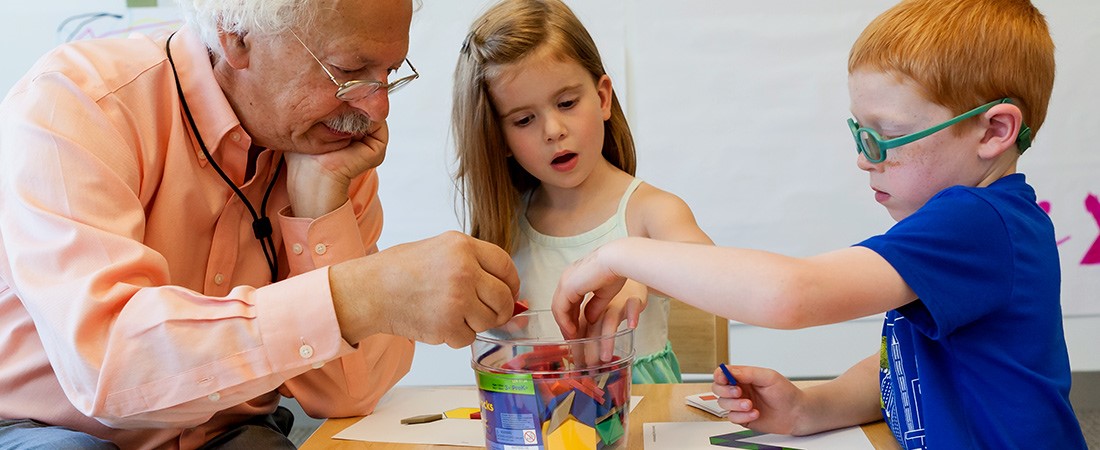5 Math Games to Inspire Young Minds

“Playing math games with children can help spark important mathematical ideas,” says Paul Goldenberg.
Looking for some fun, easy games to play with a preschooler? Try math.
Yes, math!
“Playing math games with children—even ones that we adults perceive to be simple—can help spark important mathematical ideas,” says EDC’s Paul Goldenberg. “Even better, children love them.”
But playing games isn’t just all about fun. Research has shown that informal math puzzles and games can help prepare students for the mathematical tasks they will face in kindergarten and beyond.
So, what are some simple games that can pique young mathematicians’ interest? Educators from EDC’s Games for Young Mathematicians project pick five favorites.
1. ANIMAL PUZZLES
Creating designs out of pattern blocks—those multicolored trapezoids, hexagons, and triangles that are a mainstay in most preschool classrooms—is a great way for children to build geometric thinking. While playing Animal Puzzles, a pattern block game, children also explore rotations and reflections, thus building their spatial skills.
“Building with pattern blocks is all about putting things together and then taking them apart,” says Goldenberg. “These activities help children see the world as being made up of shapes and also prepares them for later mathematical ideas.”
The best part about this activity? It is designed with a wide range of students in mind, from children who are just practicing placing the blocks to those who can complete a challenging puzzle on their own.
Skills practiced: geometric reasoning, building patterns, naming shapes
2. WHAT’S MY PATTERN?
What’s My Pattern? is another engaging game involving pattern blocks. To play, work with a child to build a pattern, and then ask the child to continue the series.
“Children are naturally drawn to patterns, and pattern recognition is a key component of algebraic reasoning,” says EDC’s Kristen Reed. “This is a fun game that children can easily play with each other.”
Building simple patterns—even as basic as rhombus, square, rhombus, square—is appropriate for even the youngest children. Teachers can vary the complexity of the pattern by adding more blocks or even repeating some of the blocks in the series.
Skills practiced: algebraic thinking, naming shapes, building patterns
3. HOW MANY ARE HIDING?
How Many Are Hiding? is a quick game that helps children practice identifying how many items are in a collection without needing to count every item singly—math educators call this subitizing. This game is especially appropriate for preschool students who already know how to count.
To play, lay out a small assortment of coins on a flat surface. Ask children to count the assortment, and then cover some up with your hand. Now ask: How many are hiding?
A fun variant of this game is to play it on your hands: “Put up a few fingers on each hand, and then ask the child to figure out how many fingers you are not raising,” says EDC’s Jessica Young. “You can really play this game anywhere.”
Skills practiced: subitizing, composing and decomposing number, comparing numbers
4. JUMPING ON THE LILY PADS
Young children might enjoy a game that helps them develop a mental number line: Jumping on the Lily Pads. In this game, children take turns rolling a number cube and moving a “frog” along the game board. The goal is to be the first whose frog reaches its lily pad.
There is advanced mathematics hiding within this game, making it a great way for children to stretch their math muscles. And parents can play an important role by asking questions, such as, “Who is further ahead?” and “How many more spaces does the frog have to jump?”
“Children have to build the idea that whole numbers are spaced equally along the number line,” says Young. “The more that children develop a mental number line, the more prepared they are for the math tasks that await them in kindergarten.”
Skills practiced: recognizing written numerals, using one-to-one correspondence when counting, subitizing, counting on
5. TWO NUMBERS
Games that build fluency with numbers are also important in the early years. One such game is Two Numbers, in which children learn to recognize written numerals, place them in the correct order, and practice addition skills.
To play, children roll dot cubes and identify the number they rolled. They then turn over either the corresponding number cards or the number card that corresponds to the sum of the two numbers. The goal is to be the first player to turn over all the number cards.
While children are identifying written numerals and practicing addition skills, they are learning how to build a mental number line as well. Reed says this is an important skill for children to develop.
“Being able to call on a mental number line helps students with addition and subtraction and also makes the transition to fractions smoother,” she says.
Skills practiced: recognizing written numerals, one-to-one correspondence, number line, addition, subtraction, composing and decomposing numbers